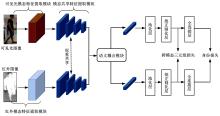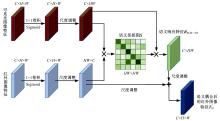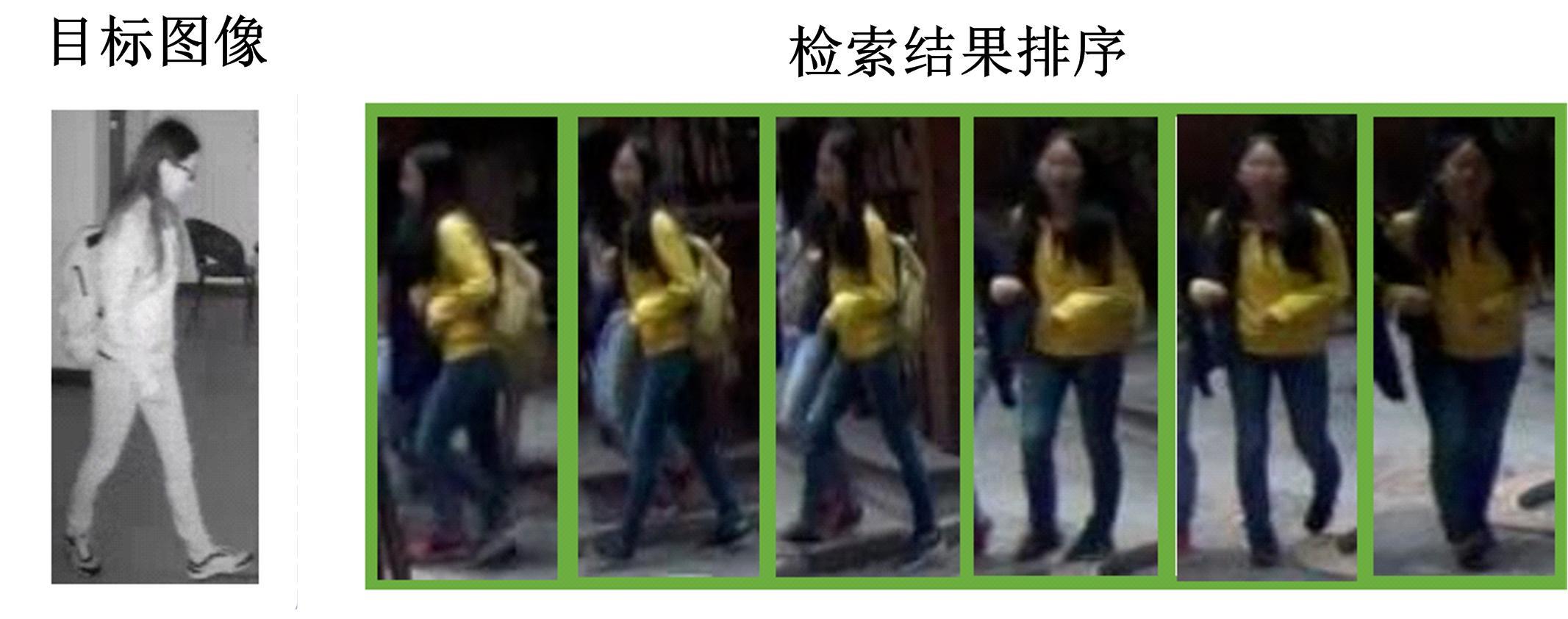吉林大学学报(工学版) ›› 2022, Vol. 52 ›› Issue (12): 2954-2963.doi: 10.13229/j.cnki.jdxbgxb20210481
基于语义耦合和身份一致性的跨模态行人重识别方法
- 天津大学 电气自动化与信息工程学院,天津 300072
Cross⁃modality person re⁃identification based on semantic coupling and identity⁃consistence constraint
Chun-ping HOU( ),Qing-yuan YANG,Mei-yan HUANG,Zhi-peng WANG
),Qing-yuan YANG,Mei-yan HUANG,Zhi-peng WANG
- School of Electrical and Information Engineering,Tianjin University,Tianjin 300072,China
摘要:
针对跨模态行人重识别面临的较大跨模态差异和类内变化的问题,提出了一种基于语义耦合和身份一致性的跨模态行人重识别方法。在语义层面,通过双向耦合不同模态的语义特征,实现不同模态间语义的交互融合,有效缓解了跨模态差异;在行人身份层面,通过优化跨模态三元组损失和身份损失,实现类内身份信息一致性,有效缓解了类内变化问题。实验结果表明,本文算法能够有效提升跨模态行人重识别精度,与基线方法相比,Top-1和mAP指标精度提升了10%以上。
中图分类号:
- TP391
| 1 | Ye Mang, Shen Jian-bing, Lin Gao-jie, et al. Deep learning for person re-identification: a survey and outlook[J]. IEEE Transactions on Pattern Analysis and Machine Intelligence, 2022, 44(6): 2872-2893. |
| 2 | Zhong Zhun, Zheng Liang, Luo Zhi-ming, et al. Learning to adapt invariance in memory for person re-identification[J]. IEEE Transactions on Pattern Analysis and Machine Intelligence, 2021, 43(8): 2723-2738. |
| 3 | Qian Xue-lin, Fu Yan-wei, Tao Xiang, et al. Leader-based multi-scale attention deep architecture for person re-identification[J]. IEEE Transactions on Pattern Analysis and Machine Intelligence, 2019, 42(2): 371-385. |
| 4 | 马淼, 王云涛, 潘海鹏. 基于注意力机制和空间几何约束的行人重识别方法[J]. 吉林大学学报: 工学版, 2022, 52(5): 1079-1087. |
| Ma Miao, Wang Yun-tao, Pan Hai-peng. Person re-identification method based on attention mechanism and spatial geometric constraint[J]. Journal of Jilin University(Engineering and Technology Edition), 2022, 52(5): 1079-1087. | |
| 5 | Chen Guang-yi, Lu Ji-wen, Yang Ming, et al. Learning recurrent 3D attention for video-based person re-identification[J]. IEEE Transactions on Image Processing, 2020, 29: 6963-6976. |
| 6 | Wang K, Ding C, Maybank S J, et al. CDPM: convolutional deformable part models for semantically aligned person re-identification[J]. IEEE Transactions on Image Processing, 2019, 29: 3416-3428. |
| 7 | Wu A, Zheng W S, Yu H X, et al. RGB-infrared cross-modality person re-identification[C]∥Proceedings of the IEEE International Conference on Computer Vision, Venice, Italy, 2017: 5380-5389. |
| 8 | Ye Mang, Wang Zheng, Lan Xiang-yuan, et al. Visible thermal person re-identification via dual-constrained top-ranking[C]∥International Joint Conference on Artificial Intelligence, Stockholm, Sweden, 2018:1092-1099. |
| 9 | Hao Yi, Wang Nan-nan, Li Jie, et al. HSME: hypersphere manifold embedding for visible thermal person re-identification[C]∥Proceedings of the AAAI Conference on Artificial Intelligence, Hawaii, USA,2019: 8385-8392. |
| 10 | Wang Guan-an, Zhang Tian-zhu, Cheng Jian, et al. RGB-infrared cross-modality person re-identification via joint pixel and feature alignment[C]∥Proceedings of the IEEE/CVF International Conference on Computer Vision, Seoul, Korea, 2019: 3623-3632. |
| 11 | Wang Zhi-xiang, Wang Zheng, Zheng Yin-qiang, et al. Learning to reduce dual-level discrepancy for infrared-visible person re-identification[C]∥Proceedings of the IEEE/CVF Conference on Computer Vision and Pattern Recognition, Long Beach, USA, 2019: 618-626. |
| 12 | Deng J, Dong W, Socher R, et al. ImageNet: a large-scale hierarchical image database[C]∥IEEE Conference on Computer Vision and Pattern Recognition, Miami, USA, 2009: 248-255. |
| 13 | He Kai-ming, Zhang Xiang-yu, Ren Shao-qing, et al. Deep residual learning for image recognition[C]∥IEEE Conference on Computer Vision and Pattern Recognition, Las Vegas, USA, 2016: 770-778. |
| 14 | Hermans A, Beyer L, Leibe B. In defense of the triplet loss for person re-identification[DB/OL]. [2020-12-03]. |
| 15 | Nguyen D T, Hong H G, Kim K W, et al. Person recognition system based on a combination of body images from visible light and thermal cameras[J]. Sensors, 2017, 17(3): No.605. |
| 16 | Kansal K, Subramanyam A V, Wang Z, et al. SDL: spectrum-disentangled representation learning for visible-infrared person re-identification[J]. IEEE Transactions on Circuits and Systems for Video Technology, 2020, 30(10): 3422-3432. |
| 17 | Feng Zhan-xiang, Lai Jian-hua, Xie Xiao-hua. Learning modality-specific representations for visible-infrared person re-identification[J]. IEEE Transactions on Image Processing, 2019, 29: 579-590. |
| 18 | Ye Mang, Lan Xiang-yuan, Leng Qing-ming, et al. Cross-modality person re-identification via modality-aware collaborative ensemble learning[J]. IEEE Transactions on Image Processing, 2020, 29: 9387-9399. |
| 19 | Ye Mang, Lan Xiang-hua, Wang Zheng, et al. Bi-directional center-constrained top-ranking for visible thermal person re-identification[J]. IEEE Transactions on Information Forensics and Security, 2019, 15: 407-419. |
| 20 | Ye Han-rong, Liu Hong, Meng Fan-yang, et al. Bi-directional exponential angular triplet loss for RGB-infrared person re-identification[J]. IEEE Transactions on Image Processing, 2021, 30: 1583-1595. |
| 21 | Wu An-cong, Zheng Wei-shi, Gong Shao-gang, et al. RGB-IR person re-identification by cross-modality similarity preservation[J]. International Journal of Computer Vision, 2020, 128(6): 1765-1785. |
| 22 | Dai P Y, Ji R R, Wang H B, et al. Cross-modality person re-identification with generative adversarial training[C]∥Proceedings of the Twenty-Seventh International Joint Conference on Artificial Intelligence, Stockholm, Sweden: 2018: 677-683. |
| 23 | Wang G A, Zhang T, Yang Y, et al. Cross-modality paired-images generation for RGB-infrared person re-identification[C]∥Proceedings of the AAAI Conference on Artificial Intelligence, New York, USA, 2020: 12144-12151. |
| 24 | 胡静,陶洋.基于RPCA的群稀疏表示人脸识别方法[J]. 重庆邮电大学学报: 自然科学版, 2020, 32(3): 459-468. |
| Hu Jing, Tao Yang. Group sparse representation face recognition method based on RPCA[J]. Journal of Chongqing University of Posts and Telecommunications (Natural Science Edition), 2020, 32(3): 459-468. | |
| 25 | 李新春,马红艳,林森.基于局部邻域四值模式的掌纹掌脉融合识别[J].重庆邮电大学学报: 自然科学版, 2020, 32(4): 630-638. |
| Li Xin-chun, Ma Hong-yan, Lin Sen. Palmprint and palm vein fusion recognition based on local neighbor quaternary pattern[J]. Journal of Chongqing University of Posts and Telecommunications (Natural Science Edition), 2021, 47(5): 285-291, 300. |
| [1] | 祁贤雨,王巍,王琳,赵玉飞,董彦鹏. 基于物体语义栅格地图的语义拓扑地图构建方法[J]. 吉林大学学报(工学版), 2023, 53(2): 569-575. |
| [2] | 时小虎,吴佳琦,吴春国,程石,翁小辉,常志勇. 基于残差网络的弯道增强车道线检测方法[J]. 吉林大学学报(工学版), 2023, 53(2): 584-592. |
| [3] | 郭鹏,赵文超,雷坤. 基于改进Jaya算法的双资源约束柔性作业车间调度[J]. 吉林大学学报(工学版), 2023, 53(2): 480-487. |
| [4] | 刘近贞,高国辉,熊慧. 用于脑组织分割的多尺度注意网络[J]. 吉林大学学报(工学版), 2023, 53(2): 576-583. |
| [5] | 高金武,贾志桓,王向阳,邢浩. 基于PSO-LSTM的质子交换膜燃料电池退化趋势预测[J]. 吉林大学学报(工学版), 2022, 52(9): 2192-2202. |
| [6] | 周丰丰,朱海洋. 基于三段式特征选择策略的脑电情感识别算法SEE[J]. 吉林大学学报(工学版), 2022, 52(8): 1834-1841. |
| [7] | 申铉京,张雪峰,王玉,金玉波. 像素级卷积神经网络多聚焦图像融合算法[J]. 吉林大学学报(工学版), 2022, 52(8): 1857-1864. |
| [8] | 曲福恒,丁天雨,陆洋,杨勇,胡雅婷. 基于邻域相似性的图像码字快速搜索算法[J]. 吉林大学学报(工学版), 2022, 52(8): 1865-1871. |
| [9] | 白天,徐明蔚,刘思铭,张佶安,王喆. 基于深度神经网络的诉辩文本争议焦点识别[J]. 吉林大学学报(工学版), 2022, 52(8): 1872-1880. |
| [10] | 李晓英,杨名,全睿,谭保华. 基于深度学习的不均衡文本分类方法[J]. 吉林大学学报(工学版), 2022, 52(8): 1889-1895. |
| [11] | 赵宏伟,张健荣,朱隽平,李海. 基于对比自监督学习的图像分类框架[J]. 吉林大学学报(工学版), 2022, 52(8): 1850-1856. |
| [12] | 秦贵和,黄俊锋,孙铭会. 基于双手键盘的虚拟现实文本输入[J]. 吉林大学学报(工学版), 2022, 52(8): 1881-1888. |
| [13] | 胡丹,孟新. 基于时变网格的对地观测卫星搜索海上船舶方法[J]. 吉林大学学报(工学版), 2022, 52(8): 1896-1903. |
| [14] | 王军,徐彦惠,李莉. 低能耗支持完整性验证的数据融合隐私保护方法[J]. 吉林大学学报(工学版), 2022, 52(7): 1657-1665. |
| [15] | 周丰丰,张亦弛. 基于稀疏自编码器的无监督特征工程算法BioSAE[J]. 吉林大学学报(工学版), 2022, 52(7): 1645-1656. |
|







